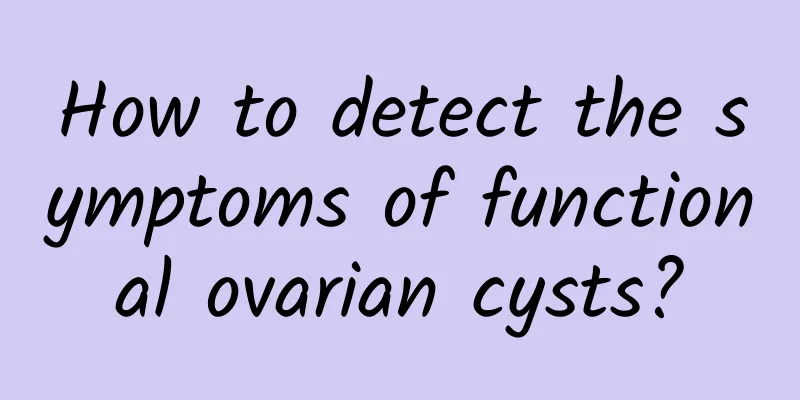How to detect the symptoms of functional ovarian cysts?

|
What are the symptoms of functional ovarian cysts? Is it easy to detect? 1. Functional ovarian cysts have no obvious clinical manifestations in the early stage, and patients are often found only during gynecological examinations when they seek medical treatment for other diseases. Later, as the tumor grows, the patient will feel it, and the symptoms and signs vary depending on the nature, size, development, and presence or absence of secondary degeneration or complications of the tumor. 2. Increased abdominal circumference and intra-abdominal masses are the most common phenomena in patients with functional ovarian cysts. After suffering from ovarian cysts, patients will feel discomfort in the lower abdomen and feel that the waist is thickening. Lower abdominal discomfort is the initial symptom before the patient touches the lower abdominal mass. Due to the weight of the tumor itself and the influence of intestinal peristalsis and changes in body position, the tumor moves in the pelvic cavity, involving its pedicle and pelvic funnel ligament, so that the patient has a feeling of distension and falling in the lower abdomen or iliac fossa. Increased abdominal circumference and intra-abdominal masses are the most common phenomena in the main complaints. Patients only notice the enlargement of their abdomen when they realize that their clothes or belts seem tight. 3. The pain caused by functional ovarian cysts may be continuous or dull. Malignant cysts often cause abdominal pain, leg pain, and pain, often requiring patients to seek emergency treatment. Usually, huge ovarian tumors can cause dyspnea and palpitations due to compression of the diaphragm. Ovarian tumors combined with a large amount of ascites can also cause ovarian cysts blocking the birth canal, causing such symptoms. However, the dyspnea of some ovarian tumor patients is caused by unilateral or bilateral pleural effusion. If the tumor has no complications, there is very little pain. Patients with ovarian tumors feel abdominal pain, especially those that occur suddenly, which is mostly caused by the twisting of the tumor pedicle, or occasionally by tumor rupture, bleeding or infection. Malignant cysts often cause abdominal pain and leg pain, and the pain often causes patients to seek emergency treatment. |
<<: What can I eat after laparoscopic surgery for uterine fibroids?
>>: Premonitions of miscarriage
Recommend
Pay attention to details in life to prevent cervical erosion
Cervical erosion is not a disease, but is mostly ...
How does pelvic inflammatory disease develop?
Pelvic inflammatory disease is mainly a pathologi...
Drinking coffee helps you lose weight! Light roasted coffee retains more chlorogenic acid
The rich aroma of coffee wafts through the street...
Pelvic peritonitis can be detected
If a woman suffers from pelvic peritonitis, the h...
What are the folk remedies for pelvic effusion?
What are some folk remedies for pelvic effusion? ...
How should women in menopause eat?
During menopause, you need to pay attention to so...
What kind of pre-abortion checks should we do?
Abortion is a common phenomenon in modern society...
What are the early symptoms of cervical erosion?
What are the early symptoms of cervical erosion? ...
When should adults get the flu shot?
The best time for adults to get the flu shot is u...
How much does it cost to test for adenomyosis?
We know that a disease needs to be diagnosed thro...
Debunking 3 myths about weight loss! Controlling aging helps with weight management
The numbers speak! Obesity has long been a seriou...
Can a small amount of pelvic effusion heal itself? How to treat pelvic effusion?
Nowadays, many women live in a fast-paced environ...
What are the symptoms of malignant ovarian cysts?
Ovarian cysts are generally benign, but some of t...
Heavy menstrual bleeding and uterine fibroids can cause anemia! Must supplement folic acid, iron, and vitamin C for balanced nutrition
Women who tend to have pale faces, frequent dizzi...
7 exercises to eliminate back fat and become a perfect back beauty
[Key Points]: Although the back is not as prone t...









